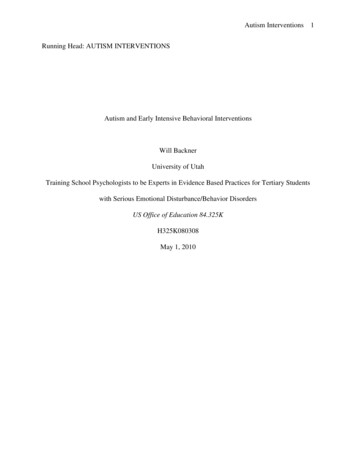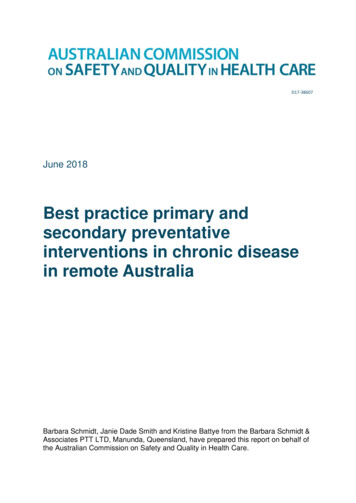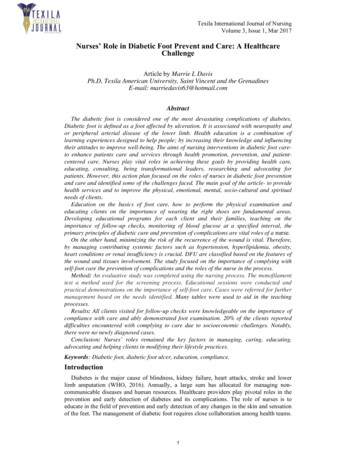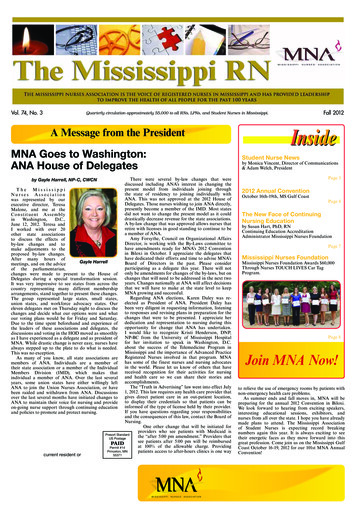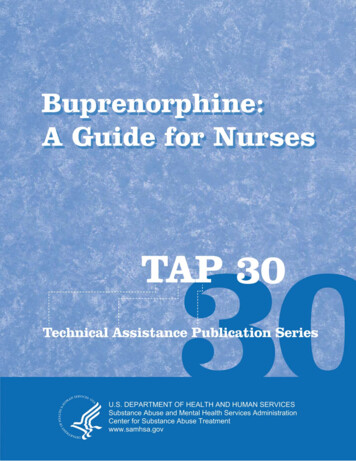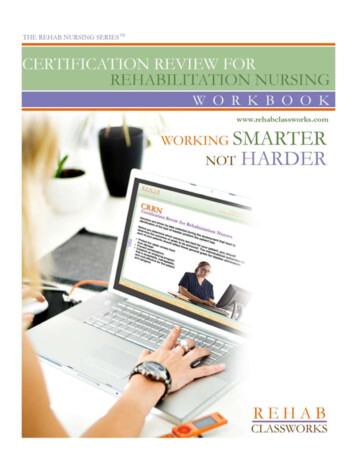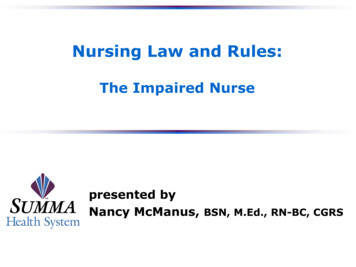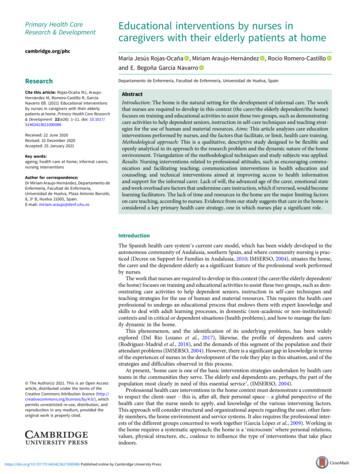
Transcription
Primary Health CareResearch & DevelopmentEducational interventions by nurses incaregivers with their elderly patients at homecambridge.org/phcMaría Jesús Rojas-Ocaña , Miriam Araujo-Hernández , Rocío Romero-Castilloand E. Begoña García NavarroResearchCite this article: Rojas-Ocaña MJ, AraujoHernández M, Romero-Castillo R, GarcíaNavarro EB. (2021) Educational interventionsby nurses in caregivers with their elderlypatients at home. Primary Health Care Research& Development 22(e26): 1–11. doi: 10.1017/S1463423621000086Received: 22 June 2020Revised: 10 December 2020Accepted: 25 January 2021Key words:ageing; health care at home; informal carers;nursing interventionsAuthor for correspondence:Dr Miriam Araujo-Hernández, Departamento deEnfermería, Facultad de Enfermería,Universidad de Huelva, Plaza Antonio Barceló,8, 3º B, Huelva 21005, Spain.E-mail: miriam.araujo@denf.uhu.esDepartamento de Enfermería, Facultad de Enfermería, Universidad de Huelva, SpainAbstractIntroduction: The home is the natural setting for the development of informal care. The workthat nurses are required to develop in this context (the carer/the elderly dependent/the home)focuses on training and educational activities to assist these two groups, such as demonstratingcare activities to help dependent seniors, instruction in self-care techniques and teaching strategies for the use of human and material resources. Aims: This article analyzes care educationinterventions performed by nurses, and the factors that facilitate, or limit, health care training.Methodological approach: This is a qualitative, descriptive study designed to be flexible andopenly analytical in its approach to the research problem and the dynamic nature of the homeenvironment. Triangulation of the methodological techniques and study subjects was applied.Results: Nursing interventions related to professional attitudes, such as encouraging communication and facilitating teaching; communication interventions in health education andcounseling; and technical interventions aimed at improving access to health informationand support for the informal carer. Lack of will, the advanced age of the carer, emotional stateand work overload are factors that undermine care instruction, which if reversed, would becomelearning facilitators. The lack of time and resources in the home are the major limiting factorson care teaching, according to nurses. Evidence from our study suggests that care in the home isconsidered a key primary health care strategy, one in which nurses play a significant role.Introduction The Author(s) 2021. This is an Open Accessarticle, distributed under the terms of theCreative Commons Attribution licence (http://creativecommons.org/licenses/by/4.0/), whichpermits unrestricted re-use, distribution, andreproduction in any medium, provided theoriginal work is properly cited.The Spanish health care system’s current care model, which has been widely developed in theautonomous community of Andalusia, southern Spain, and where community nursing is practiced (Decree on Support for Families in Andalusia, 2010; IMSERSO, 2004), situates the home,the carer and the dependent elderly as a significant feature of the professional work performedby nurses.The work that nurses are required to develop in this context (the carer/the elderly dependent/the home) focuses on training and educational activities to assist these two groups, such as demonstrating care activities to help dependent seniors, instruction in self-care techniques andteaching strategies for the use of human and material resources. This requires the health careprofessional to undergo an educational process that endows them with expert knowledge andskills to deal with adult learning processes, in domestic (non-academic or non-institutional)contexts and in critical or dependent situations (health problems), and how to manage the family dynamic in the home.This phenomenon, and the identification of its underlying problems, has been widelyexplored (Del Rio Lozano et al., 2017), likewise, the profile of dependents and carers(Rodríguez-Madrid et al., 2018), and the demands of this segment of the population and theirattendant problems (IMSERSO, 2004). However, there is a significant gap in knowledge in termsof the experiences of nurses in the development of the role they play in this situation, and of thestrategies and difficulties observed in this process.At present, ‘home care is one of the basic intervention strategies undertaken by health careteams in the communities they serve. The elderly and dependents are, perhaps, the part of thepopulation most clearly in need of this essential service’, (IMSERSO, 2004).Professional health care interventions in the home context must demonstrate a commitmentto respect the client–user – this is, after all, their personal space – a global perspective of thehealth care that the nurse needs to apply, and knowledge of the various intervening factors.This approach will consider structural and organizational aspects regarding the user, other family members, the home environment and service systems. It also requires the professional interests of the different groups concerned to work together (García López et al., 2009). Working inthe home requires a systematic approach; the home is a ‘microcosm’ where personal relations,values, physical structure, etc., coalesce to influence the type of interventions that take 0086 Published online by Cambridge University Press
2Various studies (Bohórquez et al., 2011; Hall et al., 2011; Puchi& y Jara, 2015; Del Rio Lozano et al., 2017) highlight the significance of the setting/environment, in this case, the home, in thedaily lives of residents, and their autonomy and quality of life.This is especially true of senior citizens. The ageing process affectstheir capacity to adapt; the elderly need more time to adjust to newspaces, and they require stable, recognizable reference points, bothphysical and personal, in the form of familiar faces (Fernándezet al., 2018). Control over a known space and its elements, feeling‘at home’, does not require any extra effort; it is an automatedresponse and provides a sense of security. The domestic environment is familiar and inextricably linked to the resident’s personalhistory (Ham et al., 2012).Care in the home is the standard-bearer of our health system. Itenables us to identify and know aspects and issues that no othersource of information can provide; it offers a global contextualizedperspective of the problem that should boost coordination betweensectors for resolution. Home care encourages the elderly to remainin their own environment, and increases family members’ sense ofresponsibility towards them in all aspects of their health and wellbeing. It also encourages integral patient care and strengthens theindividual’s decision-taking capacity in terms of their own healthproblems (Genet et al., 2013; Rodríguez-González et al., 2017).For centuries, attention to health problems has mainly takenplace in the social space (the community) where the home is thenatural context for care of the sick or dependents. The featureof this natural space is human participation (Aldana-Gonzalez& y Garcia-Gomez, 2011; Bernal et al., 2018), between the carerand the person in their care. This interaction makes nursing practice much more human as it enables nurse and patient to see eachother as persons, with patients having the right and obligation to bethe agents of their own health, not mere passive recipients of theactions formulated by the health care professional who attendsthem (Vabo, 2012).It is important to emphasize that the trend in social policy istowards prioritizing care of the elderly in the community, just asit is the expressed preference of the elderly to be cared for in theirown homes (Davis & y Brayne, 2015; Bayona Huguet et al., 2018).Of equal importance to instigating social policies to resolve suchproblems is the identification, analysis and interpretation of hownurses’ training is to be developed, and how the nurses themselvesinterpret it. Attention needs to focus on where difficulties arise andwhich strategies are best suited to optimizing professional resources (the nurse) to fulfil the objective of resolving the health careissues of senior citizens in their homes (Casey, 2013).The research question could be: What do nurses do when working with community-dwelling older people and their carers? Themain aim of the research described in this article is to identify educational interventions by nurses that improve the care and self-careprocesses practiced by carers with their elderly patients inthe home.María Jesús Rojas-Ocaña et al.2. To describe the factors that facilitate, or limit, the educationalprocess in care and self- care practice, as practiced by the carerin the patient’s home, from the perspective of nursingprofessionals in the field.Methodological approachThis is a qualitative, descriptive study designed to be flexible andopenly analytical in its approach to the research problem and thedynamic nature of the home environment.The study covered the Basic Health Zones operated by theHuelva District and Coast health authority, in southern Spain.The sample consisted of 18 health care professionals workingout of health care centers in the city of Huelva. The participantswere selected by intentional sample using the personal networkprocesses in operation at such centers.Triangulation of the methodological techniques and study subjects was applied:1. Triangulation of subjects: the points of view of those sampledwere contrasted based on the type of nursing activity developedin the various zones studied: Liaison Nurse, Community Nurseand Nurse Educator.2. Triangulation of methods: differences and similarities werecontrasted in the description and assessment of the difficultiesarising from the development of the nursing intervention that isthe object of this research, according to each participant’s perspective (Gatha Nursing instrument), interviews and group discussions (Figure 1).The Gatha nursing instrumentA total of 192 observations of home visits were carried out. TheGatha Nursing tool gathered 35 items on three axes: professionalattitudes, communication tasks, and technical skills (Annex 1).This instrument was designed based on work initiated by the‘Health and Communication’ group of experts to adapt theGatha Base (Prado et al., 2003). This tool has been successfullyapplied in research on the communication profile of general practitioners and their training, and was initially validated by experts in1993, 1994, and 1995. It has since been adapted to a range of media,its principal strength being the validity of its content.Triangulation of the data concluded with eight individual interviews, four case management nurses and four community nurses,to achieve data saturation (Creswell, 1998), and a group discussionamong six participants: three community nurses and two casemanagement nurses from the Huelva District and Coast healthauthority, and a nursing student from the University of Huelva.Inclusion criteria were: voluntary participation in the study, andbeing on active duty at the time of the interviews or groupdiscussion.Data treatment: processing, analysis and interpretationAimsThe main aim of the research described in this article is to identifyeducational interventions by nurses that improve the care and selfcare processes practiced by carers with their elderly patients inthe home.Specific aims:1. To identify and observe educational interventions by nurses inthe home of the elderly patient.https://doi.org/10.1017/S1463423621000086 Published online by Cambridge University PressThe data obtained by observation in patients’ homes using theGatha Nursing instrument were analyzed using the Windows’SPSS V.17 software program. This descriptive analysis enabledus to identify, using the nursing interventions classification(NIC) tool, those activities that matched the items gathered bythe Gatha instrument, and the corresponding intervention. Wealso extracted data from the context where the nursing activity tookplace, and on those aspects that could facilitate, or hinder, thelearning process in the home. Based on the home observations,
Primary Health Care Research & DevelopmentFigure 1. Triangulation modalities used.we analyzed dimensions and categories by triangulating betweenthe observations and the data obtained from interviews (on subjects and techniques).Deductive coding was used based on the information from theelements observed in the home in relation to the context, and onthe determining factors and interventions in the home, which wereclassified as dimensions, categories and subcategories.Table 1 presents the dimensions established by the researcherfor the home observations, interviews and group discussion.ResultsThe results based on the methodological techniques used are asfollows:The observationsDescriptive profilesThe 192 visits were carried out in six health centers in the city ofHuelva, Spain and were distributed as shown in Figure 2.The number of health care professionals who undertook thesehome visits was 18, of whom 16.7% were male and 83.3% female.The mean age of the nurses was 48.8 with a standard deviation of6.2. The professional profile was of 25.7 years’ experience in nursing, with a standard deviation of 5.8, and primary care experienceof 15.6 years. The majority (83.3%) declared that they belonged to aprofessional nursing organization.The Experience and training of nursing undergraduates in communication and clinical interviews is present in Table 2.Within the care activity context (Gatha Nursing instrumentpoint II), the type of attention administered (scheduled visitsand unscheduled call-outs) and the type of care (interventional,mixed and assessment.) are summarized in Figure 3.Those who were the object of the visit were classified as primarypatients, visits directed at the carer and secondary patients (to treathealth problems of the carer because of their work with the patient athome). In such cases, 79.3% of those visited were women (Figure 4).The Gatha instrumentRecording nurses’ educational interventions by home observationand the use of the Gatha Nursing tool was performed as follows.An intervention by a nurse was considered completed when theitem was performed in 75% or more of the observations. NIC identified those interventions that matched the items of the Gathainstrument, and the corresponding intervention (Table 3).https://doi.org/10.1017/S1463423621000086 Published online by Cambridge University Press3All these items have a compliance level of above 75%. The tableshows the instrument’s axes and the Gatha items that indicate thenursing interventions.The axes included in the Gatha Nursing instrument consist of:Axis 1. Professional Attitudes:All 192 health care professionals (100%) begin their visit bygreeting the patient on arrival in their home and addressed thepatient by their name (P2).All 192 health care professionals (100%) showed respect in theircommunications with the patient (P3), and smiled at some pointduring the session in 191 (99.5%) of the visits recorded (P4). In allcases, they looked directly at the patient when talking or listeningto them (P5).During 181 (94%) of the visits, the nurse allowed the patient tocommunicate, with 11 (5.7%) sessions recording no communication (not applicable) due to the patient’s pathology (P6).On 149 (77.6%) occasions, the nurse took into consideration thepatient’s opinion at all times, demonstrating a high degree ofunderstanding (P7).The health care professionals attended to the questions of thepatient and provided clarifications in 166 (86.56%) of visits (P8).On 179 (93.2%) occasions, we observed that the nurses treatedthe patient as adults without using paternalistic language (P9).During 144 (75%) of the visits, nurses always discussed sensitiveissues with those patients who manifested their fears and concerns(P10); this item was not applicable in the remainder of the sessionsdue to the nature of the visit, which was to perform a technicalaction that the patient was used to receiving.In 183 (95.3%) of the visits, the health care professionals manifested verbal and non-verbal expressions of support and understanding with the patient (P11). All the visits were marked bynurses’ coherence in the verbal and non-verbal language used,and all said goodbye to the patient.InterviewsHere we describe the categories prior to the interviews, as well asthose that emerge during them (context, elements that facilitate, orlimit, learning in the household).ContextThe context where the care activity is performed and its infrastructures are an important point of analysis in this study, likewise thecharacteristics, elements and actors in this situation. The homemust be seen as a ‘microsystem’ where personal relationships, values, physical structure, etc., interact simultaneously to influencethe type of intervention that takes place within. To better understand how the carers learn to carry out care activities, it is important to know the personal characteristics of the carer, their skillsand capabilities, the context in which they administer the careand the resources they can count on.The home is the space where all the human responsesinvolving the patient and carer take place. The action of providing care to the patient is only possible if the nurse can applythe communication skills acquired to identify and characterize(diagnostic judgement phase) the general situation of the person, the health problems they present and how these problemsare affected by social and psychological factors. The health careprofessional also needs to know how the person identifies theirproblem and how they feel about it, the type of mechanisms(human responses) to put into operation, and the extent to
4María Jesús Rojas-Ocaña et al.Table 1. Collection of information in the different methods used: observation, interview, and discussion XFamilyXXXEnvironmentalXXXPromoting communicationXXXCognitive RestructuringXXXProgram developmentXXXMain caregiver supportXXXMemory trainingXXXHealth educationXXXEnable teachingXXXImproving access to healthinformationXXXFamily ries1. Context2. InterventionsSubcategoriesStrengthKnowledgeWill3. Determining Factors ofLearning4. Professional regiversActive listeningXXXSetting common goalsXXXSupport in decision makingXXXEmpowerment of learning itionXXSatisfactionXXFigure 2. Distribution of observations by Health Centers.which these mechanisms function within the person’s ownprocess. We must also consider the individual characteristicsof the person, prior shared history of carer and patient, andhttps://doi.org/10.1017/S1463423621000086 Published online by Cambridge University Pressthe values and beliefs that prevail in the context, where thenurse is a guest and where they must deliver health care attention to the patient.
Primary Health Care Research & Development5Table 2. Experience and training undergraduates nursing in communicationand clinical interviewSufficient theoreticaland practicaltrainingNoneBasicunderstandingExperience incommunicationamong nursingundergraduates44.8%44%11.2%Pre-grade trainingin clinicalinterview27.8%55.5%16.7%In terms of sociodemographic features, the carer profilematches that found in other research on carers who look afterthe elderly (Abellán et al., 2018). The carer tends to be amiddle-aged woman who is responsible for domestic chores(Prado et al., 2003), this person being the wife or daughter(Trivedi et al. 2014; Coira & y Bailon, 2014) who lives with the person they take care of; in most cases the carer is married to thepatient, and has no academic qualifications (Delgado et al.,2014; Del-Pino-Casado et al., 2014; Abellán et al., 2018). The careris typically female, which is line with the gender stereotypes in oursociety (Vicente et al., 2014).What is the nature of the context in this study?Three categories were used in the analysis of the dimension ofcontext: Personal: the extent of the contribution of the characteristics ofthe carer in the home, which can involve their state of mind, levelof education, willingness, physical circumstances, etc. Family: this aspect broadens the context by involving the socialnetworks of each individual within the household, drawing onresources, support and family relationships. Environmental: this extends the notion of physical context byencompassing variables such as the household’s state of cleanliness, lighting, noise, the setting in general, etc.Table 4 presents a summary of the segments found and groupedin categories.Factors that determine learningThis dimension includes all elements that facilitate, or limit, theprocess of training by the nurse of the carer in the home.Learning in this context is conditioned by the personal and situation factors analyzed in this article. Table 5 provides a summaryof the two main blocks: factors that facilitate learning and factorsthat limit learning.Group discussionThe group discussion analysis yielded a new category within thedimension of factors that determine learning, defined as a subcategory – limitations on learning. This subcategory was highlightedby nurses in the group discussion, and is described in Table 6.Finally, as a synthesis of the information gathered in the triangulation process involving the nurses’ perspectives and the datagathering techniques used in the study, we analyzed the data separately in the form of observation, interview, and group discussion.Table 7 shows that in the initial survey involving participant observation, the nursing interventions collated by the researcher shapedthe first emerging categories that were then used in the interviewsand group discussion to carry out a detailed examination of theeducational interventions and activities developed in the home.DiscussionThis study aimed to determine the educational interventions developed by nurses who attend patients and liaise with carers in the home,in the Basic Health Zones operated by the Huelva District and Coasthealth authority, in southern Spain. The aim was also to study the factors that facilitate, or limit, this educational process.https://doi.org/10.1017/S1463423621000086 Published online by Cambridge University PressThe visits by nurses were almost entirely scheduled, by prior agreement between patient/carer and nurse. The content of the visit consisted of controlling and monitoring the patient, and was anopportunity to provide learning and support, training for the carerand in self-care techniques, among other tasks (Bernal et al., 2018).The Bernal study carried out in a home environment describesthe practice of domestic care assistance, focusing on the emotionalhealth and stress factors that affect the main carer, their spiritualwellbeing, their performance and training in care, the resistancethey might display, and the execution of their technical role.The latter included administration of treatments, cures, bandages,control of vital signs, and assessment of physiological needs. Thestudy also examined the carer’s educational role in illness prevention/promotion of good health, in preventive activities and activities promoting health education; psychosocial factors, such as theassessment of needs and social problems, and dealing with emotional problems of the patient and carer.In a review of 33 studies on interventions involving family carers,Bustillo et al. (2018) found that the majority of such investigationsaimed to find ways to improve carers’ emotional state and relieve theburden of work. The content and development of the interventionswere not always clearly defined. Most interventions were physical–educational (Marante et al., 2014; Cristancho-Lacroix et al., 2015) orpsychosocial (Brown et al., 2015); they also carried out clinical interviews to resolve problems (Otero et al., 2014) and even includedphone and video phone calls (Steffen & Gant, 2016).The interventions comprised activities developed with carers asboth a resource or as a patient, with the nurse providing instructionand information. This included imparting knowledge and information on the home patient’s illness, hygiene for the bed-bound,how to change the patient’s position, adapting a diet to thepatient’s needs, and safety and prevention measures (Espinoza& y Jofre, 2012; Adelman et al., 2014). The literature has numerousstudies centered on interventions developed to benefit carers, mostof which analyze their workload, wellbeing, perceived social support, and perception of their stress levels or physical condition,among others, as in the study by Delgado et al. (2014).Other personal attributes detected by nurses that are believed tointervene in the carer’s learning process are the lack of energy andmotivation, difficulties arising from the family’s history, workoverload and the emotional burden involved, lack of support fromthe rest of the family and awkward personal relationships, as highlighted by Rodriguez-Gonzalez et al. (2017), for example.Conflict or lack of harmony in the family has negative consequences both for the care recipient, who might subsequentlyreceive less support than required, and for the carer, who feelsthe burden of looking after the patient. Lizarraga et al. (2008) carried out a psychotherapeutic intervention with the aim of
6María Jesús Rojas-Ocaña et al.Figure 3. Type of inquiries and activitiesperformed.Figure 4. People who are the subject of nursecare. Distribution by sex.improving carers’ emotional state by using a cognitive-behavioralapproach that applied Pearlin’s Stress Process Model (Pearlinet al., 1990; Deví & Ruiz, 2002) to patient care in the home.This model uses variables such as context conditions similar tothose in our study, including the carer’s sociodemographic characteristics, social and family networks, history of the relationshipbetween patient and carer, and social support as stress factors andmodulating variables.As in our study, Bernal et al. (2018) found that carers’ lack ofinformation and motivation, and lack of awareness of the situationin which they operated necessitated health care education forcarers to avoid patient dependence and excessive demands onthe health care system. Puchi and y Jara (2015) had similar resultsto ours, emphasizing the importance of communication skillswhen dealing with the patient and family, focusing on interventions for the care of the carer, fostering their competence in careactivities, encouraging practices that strengthen the patient’shealth and developing the role of health care provider.Numerous studies have focused on general education interventions at national and international level (Rojas-Sánchez et al., 2009;Guevara et al., 2011; Azzolin et al., 2013; Corrales & y Sánchez,2018; Hernández Bernal et al., 2018). The study on nursing communication with families by Pérez-Fernández et al. (2009) appliedhttps://doi.org/10.1017/S1463423621000086 Published online by Cambridge University PressNIC to detail nursing interventions and activities, and coincidedwith our study in finding actions such as support for the maincarer, fostering communication, active listening, and familyinvolvement.Azzolin et al. (2013) applied NIC in a study of heart failureinterventions in the home; of the 11 interventions observed, 8 wereshown to be effective, that is, they showed significant improvementwith the performance of interventions similar to those in our context, namely, symptoms control, tolerance of the activity, andenergy conservation.Developing a Program is the cornerstone of nursing interventions, in which nurses must identify needs, prioritize objectives anddescribe the activities to be carried out, in other words, all stepsinvolved in the nursing process. Puig (2009) Llobet’s thesis on careand quality of life describes how all the nursing professionals interviewed applied the Nanda Nursing Diagnosis and adhered to thenursing process in their home care visits, detecting the needs ofelderly dependents and those of their carers.Another crucial event in nurses’ home care activity is the firstcontact, ‘the welcome’, with the patient and family. The mainobjective of this first contact is to establish trust and forge a strongalliance. Pérez-Fernández et al. (2009) used the ‘fostering communication’ intervention in a nursing plan for welcoming the relatives
Primary Health Care Research & Development7Table 3. Gatha instrument axes, items and the interventions obtainedGatha axesGatha itemsInterventionsAxis 1 Professional attitudes (openness, respect, closeness, understanding, empathy, security : : : )1,2,3,4,6,11,12,13,143,4, 5,6,7,11,138,9,118,9,11,12,136,7,8,9 101 112,13Fostering communicationActive listeningEstablishing common goalsFacilitating teachingPresenceAxis 2 Communication tasks: gathering ng common goalsHealth educationFamily involvementCounselingCommunication tasks:Establishing a care plan21,22,23,242524,2522,23,24,25Developing a programSupport for decision takingBoosting learning capacityCounselingCommunication tasks: Monitoring the care plan26,272826,27,28Health educationDeveloping a programFamily involvementAxis 3 Technical skills: Gathering information29,3029,30Facilitating teachingCognitive restructuringTechnical skills: Disseminating educational content31,32,33,34,35Improving access to healthinformationFacilitating teachingHealth educationCounselingMemory trainingSupporting the main 1,32,34,35of patients hospitalized in an intensive care unit, and classified it asa necessary nursing competence. Here, nurses displayed attributessimilar to those fo
Navarro EB. (2021) Educational interventions by nurses in caregivers with their elderly patientsathome.PrimaryHealthCareResearch & Development 22(e26): 1-11. doi: 10.1017/ S1463423621000086 Received: 22 June 2020 Revised: 10 December 2020 Accepted: 25 January 2021 Key words: ageing; health care at home; informal carers; nursing interventions
